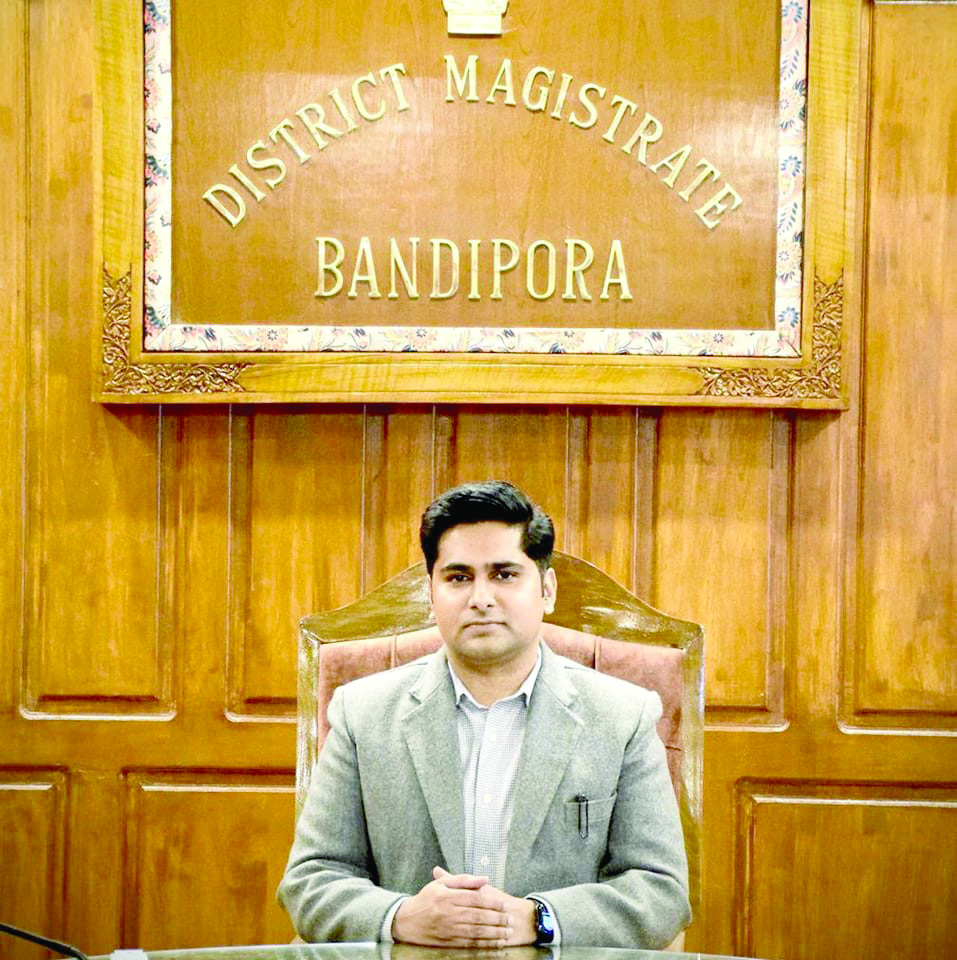In an exclusive interview with Rising Kashmir Correspondent Shafat Malik , Deputy Commissioner of Bandipora, Dr. Owais Ahmed, shares insights into his tenure, marked by transformative initiatives addressing the challenges of the COVID-19 pandemic and propelling tourism in the district to new heights. From strategic measures during the pandemic to pioneering projects in tourism, e-governance, and local development, Dr. Owais Ahmed highlights the collaborative efforts that have earned Bandipora recognition at both national and regional levels. Excerpts
What challenges did you face when taking over as DC Bandipora during the COVID-19 pandemic in 2020?
When I joined as DC, Bandipora had many erupting hotspots, especially areas like Gund Jahangir, Gund Dachina. I augmented the central control room and field teams. A multipronged approach towards the policy of Test, Trace, and Treat got us satisfactory results.
How did you manage the situation in the village that became the first mass-infected area in Kashmir due to COVID-19?
Gund Jahnagir was a unique example where one COVID death gave us 54 positive cases. With the help of about 24 dedicated teams, we screened the whole population of this hamlet, and 429 individuals were quarantined in a single day at multiple facilities based on screening results.
Tell us about the initiatives you took to elevate tourism in Bandipora to new heights?
And How has tourism contributed to changing the socio-economic conditions of the Gurez Valley?
Tourism has had a multiplier effect, improving socio-economic conditions. District Bandipora’s tourism stands as a major strength, driven by attractions like Wullar Lake and Gurez Valley. The administration adopted a comprehensive approach, involving stakeholders such as the Tourism Department, PRIs, Tour Operators, and local youth. Priority destinations, Gurez Valley and Wullar Lake, witnessed initiatives like Tent Clusters, Home Stays, and improved connectivity. Collaborative efforts led to a remarkable increase in tourist influx, from 2000-3000 in 2020 to around 50,000 in 2023. Recognized as the Best Off-Road Destination in gold Category and Dawar Village as Best Tourist Village in the country by Ministry of Tourism, Govt. of India.
Let me also make a mention that these initiatives have got a specific nomenclature – “The Gurez Model of Tourism Promotion”.
How did it feel to receive the Best Award for e-Governance during the 24th National Conference on e-Governance for the innovative digital product “Panchayat Development Index”?
The award was a great recognition of the dedicated efforts of “Team Bandipora,” and the entire district cherished the moment with great enthusiasm.
What inspired the development of the “Panchayat Development Index,” and how has it impacted local governance?
During the course of review of developmental initiative and works and expected outcomes, it was observed that resource allocation, growth and development across different sectors was quite uneven and there was no proper monitoring mechanism for expected outcomes and improvement of essential parameters and developmental indicators. This was the guiding factor for having a uniform measurable tool of development at the very basic unit of development i.e. Panchayat.
With the strengthening of local governance in terms of a first ever functional 3-Tier Panchayati Raj System, he PDI was developed to monitor developmental indicators at the Panchayat level and same significantly impacted the desired progress in sectors like education, health, nutrition, etc. The impact and recognition of PDI can be understood from the fact that after its successful implementation in District Bandipora, it has been replicated in all the Districts of UT of J&K and is also being considered for replication/implementation at National level.
Share the highlights of organizing the first-ever winter tribal festival in J&K to promote tribal culture?
District Bandipora has around 25% of tribal population comprising predominantly of 02 Tribes viz. Dard Shin living in Gurez Sub Division and Gujjar & Bakarwal living in various upper habitations of Tehsil Bandipora, Aloosa and Ajas. Initiatives were undertaken to bring tribal areas on the tourism map. The first-ever Tribal Festival in Ketson and Snow Festivals at Athwatoo and Surinder successfully promoted these spots, attracting significant tourist influx.
Can you elaborate on the initiatives implemented to double the milk production in the district, surpassing the national average?
Initiatives included subsidies for high-yielding cows, establishing veterinary clinics, training farmers, promoting artificial insemination, and creating milk collection centers. The district’s annual milk production doubled to 135 MT, surpassing the national average.
Tell us about the strategies employed to make Sumlar village a hub for trout fish farming and create employment opportunities for the youth.
Awareness drives were launched, explaining the economic benefits of fish farming. The private trout fish production increased significantly, providing employment and income opportunities to hundreds of youth.
Tell us about important milestones achieved in overall development, particularly the infrastructure development in various sectors across the District during the last 3-4 years?
Achievements include macadamizing over 700 kms of roads, connecting Gurez Valley with a power grid, completing Wullar Dredging, and transparently completing around 3000 works under various schemes.
What role do you see digital innovation playing in the continued development of Bandipora?
Digital platforms/solutions play a crucial role in public service delivery. Solutions like PDI and other platforms provided by IT departments have a monumental role in the district’s development.
Can you discuss any upcoming projects or initiatives aimed at further enhancing the district’s growth and prosperity?
Projects in the pipeline include a Study Centre/Knowledge-cum-Library Centre, Bye-Pass Road, Tourism Promotion, Cable Car Projects, Water Sports Centre, Indoor Stadium, and Auditorium.
In what ways has the district administration engaged with local communities to ensure their active participation in development projects?
Public outreach and engagement, especially with youth, have been priorities. Innovative approaches, like digital interactions, Mega Youth Festivals, and weekly Block Diwas Programs, ensure participative planning and execution of developmental initiatives.








